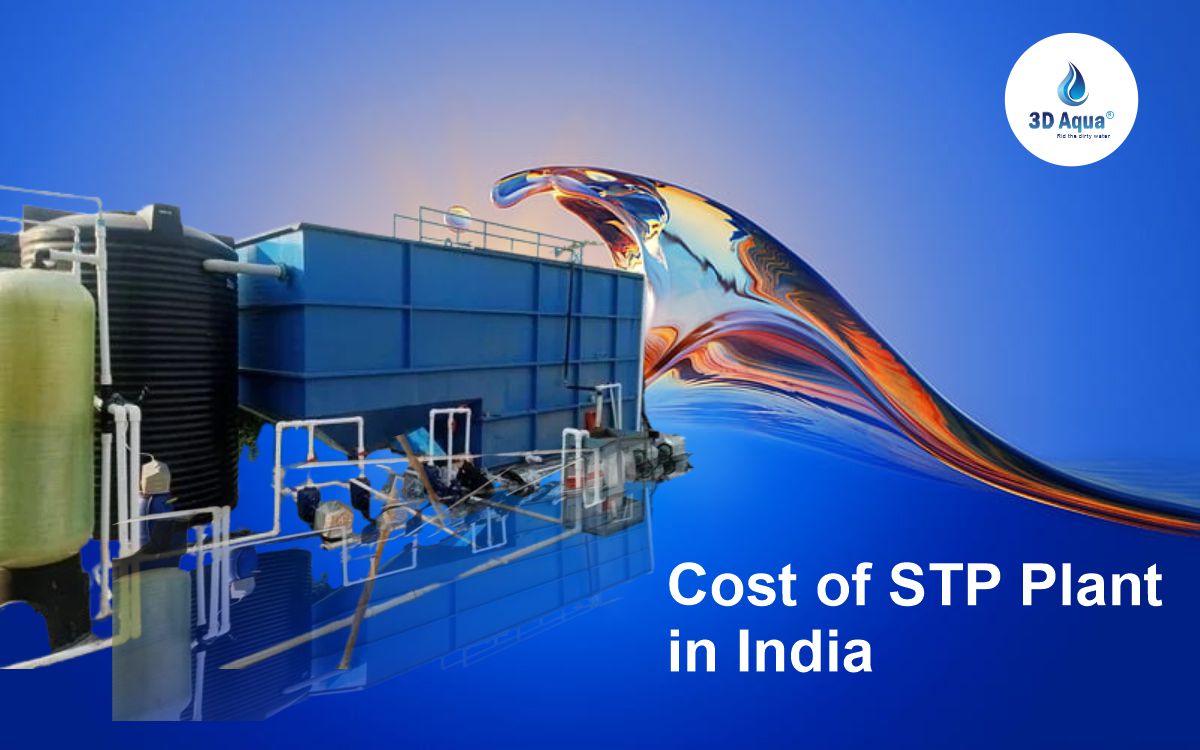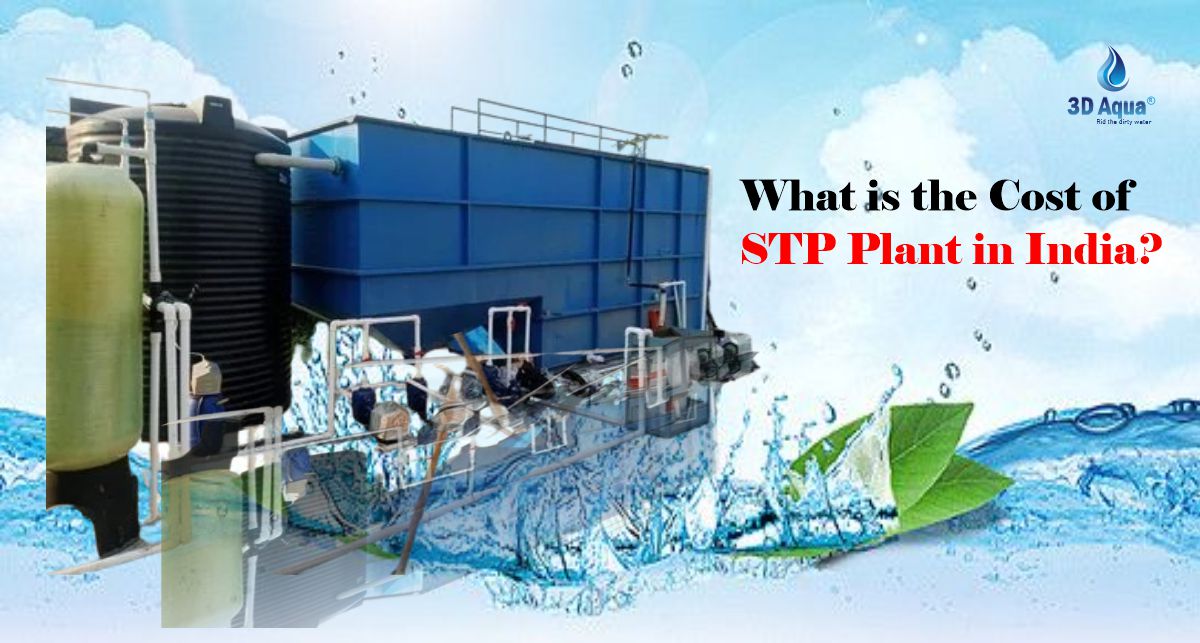What is the Cost of Building an STP Plant in India?
Water is one of the most precious resources on Earth. With growing urbanization and industrialization, sewage treatment has become a crucial component of sustainable development. A Sewage Treatment Plant (STP) ensures that domestic and industrial wastewater is treated before being discharged into the environment. Understanding the cost of building an STP plant in India is essential for industries, residential complexes, and municipal bodies planning to invest in a sustainable sewage solution.
This comprehensive guide outlines the major cost factors involved in building an STP and why 3D AQUA is a trusted name when it comes to high-quality sewage treatment systems.

Why STPs Are Important Today
Before we break down the costs, it’s important to understand why installing an STP is not just a legal mandate but a responsible business and civic decision:
- Protects water bodies from sewage contamination
- Helps in reuse of treated water for gardening, flushing, and industrial use
- Keeps organizations compliant with Pollution Control Board regulations
- Reduces long-term operational and environmental costs
What Affects the Cost of Building an STP Plant?
STP costs are not uniform. They depend on various factors including capacity, technology used, material quality, installation complexity, and vendor services. Let’s examine these in detail.
1. Plant Size and Treatment Capacity
Why Size Matters
The size of the plant, measured in KLD (Kilo Litres per Day) or MLD (Million Litres per Day), is the biggest driver of cost. A larger STP is designed to handle higher sewage volume, which requires bigger tanks, more pumps, enhanced aeration systems, and stronger materials.
Estimated Costs by Capacity
| STP Capacity | Approximate Cost |
|---|---|
| 2 KLD | ₹4 – ₹5 Lakhs |
| 10 KLD | ₹7 – ₹9 Lakhs |
| 25 KLD | ₹12 – ₹15 Lakhs |
| 50 KLD | ₹18 – ₹25 Lakhs |
| 100 KLD | ₹25 – ₹35 Lakhs |
| 500 KLD | ₹60 Lakhs – ₹1.2 Crore |
| 1 MLD+ | ₹2 Crore and above |
💡 3D AQUA offers plants from 1 KLD to 500 MLD, ensuring a tailored solution for individual homes, industries, and municipalities.
2. Technology Used in the STP
Why Technology Impacts Cost
Different treatment technologies require different components and energy levels. High-end systems offer superior treatment quality, compact design, and energy savings, but come at a higher initial cost.
Popular STP Technologies and Cost Trends
- Activated Sludge Process (ASP) – Low to moderate cost; widely used
- MBBR (Moving Bed Biofilm Reactor) – Medium cost; compact and efficient
- SBR (Sequencing Batch Reactor) – Medium to high cost; automation-driven
- MBR (Membrane Bio Reactor) – High cost; delivers ultra-pure treated water
- SAFF (Submerged Aerated Fixed Film) – Moderate cost; used in large capacities
💡 3D AQUA recommends MBBR for small/medium setups and MBR/SAFF for large or high-compliance projects.
3. Construction Materials
Material Selection and Its Role in Long-Term Costs
A durable plant built with quality materials saves on future repairs and operational inefficiencies.
- Polypropylene (PP) tanks are corrosion-resistant and long-lasting (up to 25 years).
- FRP (Fiberglass Reinforced Plastic) is lightweight and durable.
- MS (Mild Steel) with epoxy coating is used in industrial environments.
- SS (Stainless Steel) is used for premium installations with chemical-heavy discharge.
💡 3D AQUA uses PP and FRP tanks with up to 25 years warranty, along with high-quality pumps, pipes, and valves.
4. Installation, Civil Work & Site Integration
What’s Included in Installation Costs?
STP installation goes beyond placing equipment. It involves:
- Site layout and leveling
- Civil foundation for tanks and machinery
- Electrical panel setup
- Plumbing and trenching
- Commissioning and testing
Poor planning in this phase leads to delays, hidden charges, and performance issues.
💡 3D AQUA offers turnkey solutions — from design to training — ensuring smooth, cost-effective project execution.
5. Operating and Maintenance Costs (OPEX)
Recurring Costs After Setup
While capital expenditure (CAPEX) is important, OPEX affects the total lifecycle cost. Monthly expenses include:
- Electricity (for blowers, pumps, etc.)
- Chemicals (chlorine, alum, etc.)
- Staff salaries
- Regular servicing and lab testing
| STP Size | Monthly OPEX Range |
|---|---|
| 2–10 KLD | ₹10,000 – ₹25,000 |
| 25–50 KLD | ₹30,000 – ₹60,000 |
| 100+ KLD | ₹75,000 – ₹1.5 Lakhs |
💡 3D AQUA reduces OPEX through energy-efficient motors and blowers, and offers AMC (Annual Maintenance Contracts) to ease client burdens.
6. Legal Compliance and Subsidy Benefits
Why Compliance Matters
Environmental laws in India require STPs for:
- Residential complexes over a certain area
- Hotels, hospitals, malls, and schools
- Industries generating wastewater
Non-compliance results in fines, shutdowns, and legal action.
Government Subsidies
Many state governments offer financial incentives, GST rebates, or direct subsidies for installing STPs.
💡 3D AQUA assists clients in navigating paperwork, subsidy application, and pollution board certification.
Why Choose 3D AQUA for STP Solutions?
Selecting the right vendor not only affects the cost of building an STP but also influences operational efficiency, long-term savings, and compliance.
✅ Engineering Excellence
- Customized plant design based on space, inflow, and discharge norms
- Site visits for accurate planning
- AutoCAD designs and hydraulic flow analysis
✅ Premium Materials
- Long-life tanks and corrosion-proof piping
- Efficient blowers, diffusers, and pumps from reputed brands
- Automation features for less manpower usage
✅ One-Stop Service
- From design to installation, training, and after-sales
- AMC support with 24×7 helpline
- On-site startup and commissioning by certified engineers
✅ Complete Cost Transparency
- No hidden costs or surprise charges
- Detailed quotation with civil, electrical, and mechanical scope
- Consultation on how to reduce both CAPEX and OPEX
Cost Optimization Tips
Here are expert tips from 3D AQUA to reduce your STP project costs:
- Choose compact MBBR or SBR technologies for space savings.
- Use modular units that can scale with your future needs.
- Opt for energy-saving motors and smart controllers.
- Take AMC and staff training packages to cut service costs.
- Reuse treated water to lower fresh water bills.
Who Should Install an STP?
- Housing societies and apartment complexes
- Hotels and resorts
- Hospitals and medical centers
- Educational institutions
- Industrial units and manufacturing plants
- Townships and smart cities
💡 Whether you need a 2 KLD plant for a villa or a 500 MLD STP for a smart city — 3D AQUA has a proven solution.
Conclusion: What is the True Cost of Building an STP?
The cost of building an STP plant in India ranges from ₹4–5 lakhs for small units to ₹2 crore and above for large-scale systems. The exact cost depends on capacity, technology, material, and support services. But more than the price tag, it is value, efficiency, and compliance that define success.
With over 1000+ installations across India, 3D AQUA offers smart, scalable, and cost-effective STP solutions with a commitment to sustainability and service.
Need a Custom STP Cost Estimate?
Talk to the experts at 3D AQUA and get a free consultation on your project needs. We’ll help you design a plant that meets your budget, site conditions, and environmental targets.
📞 Contact Us:
Phone: +91-6262629090
Email: info@3daqua.in
Website: www.3daqua.in

